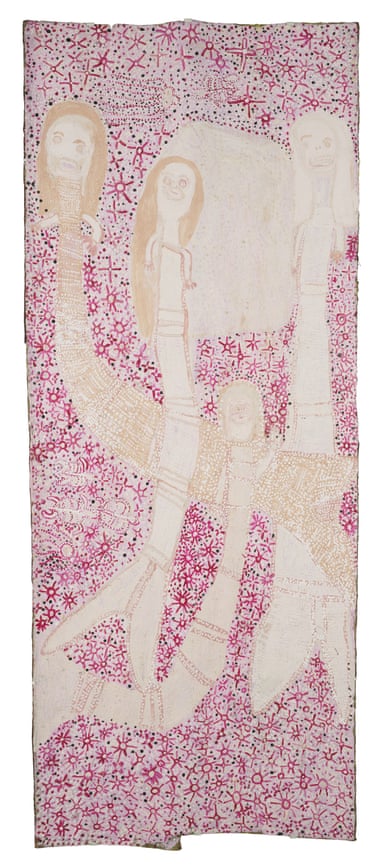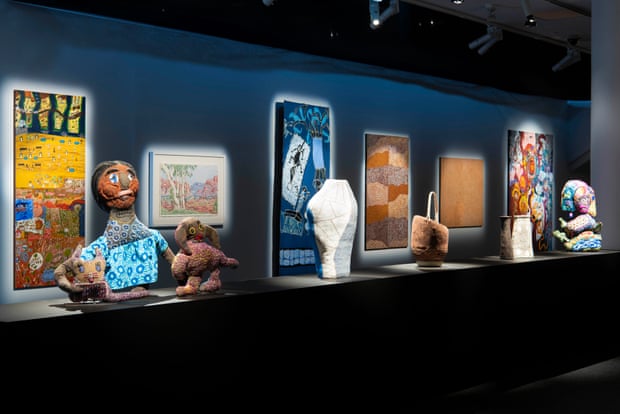A “monumental” hand-woven pandanus sail symbolizing the centuries-long relationship between Yolngu of Arnhem Land and their Macassan neighbors in Indonesia, has taken out first prize in the prestigious National Aboriginal and Torres Strait Islander art awards (Natsiaa).
Margaret Rarru Garrawurra, a senior Yolngu artist from Lanarra in Arnhem Land, created the stunning 2.8m-high hand-woven pandanus sail over several months of daily work.
Garrawurra, who won the bark painting award in 2005, said she is “proud and happy” to win the main prize of $100,000 for Dhomala (pandanus sail), which is about her cultural identity and connection to her father, as well as the historical relationships that endure between Yolngu people and the Macassans.

“I was with my sisters when I found out about winning. We were very happy. It makes us proud to get first prize,” Garrawurra, known as Rarru, said.
“Yolngu people were watching Macassan people weaving their dhomala over time… then they started to make them. My father picked up the skill as well. I used to make them.
“I thought about how I made them, my father, and I started remembering. And now I’m making these.”
The sail features stripes of distinctive black-dyed pandanus. As a senior weaver at Milingimbi arts centre, Rarru knows the recipe for creating the black mole (dye) she uses – and use of mole is reserved for her, and those to whom she gives permission.

Rarru said the work took months to create, from collecting pandanus and dyes in July last year, and weaving from October to March “every day, morning to night” before it was complete.
The Natsiaa judges said the work was “a monumental sculpture that is both majestic in scale and exacting in technical virtuosity.”
“Hers is a powerful work which reminds us that Yolngu have long been active and intrepid explorers, participating in international trade since well before the arrival of the Europeans,” Myles Russell Cook and Dr Joanna Barkmann, the judges, said.
Winner of the work on paper was Larrakia artist Gary Lee for a beautiful portrait of his grandfather, adorned with white blooms.
The late Ms D Yunupingu from Yirrkala won the bark award for her joyous retelling of an important mermaid story that is also a story of her relationship with her father and traditional sea country. Ms Yunupingu, who became a master painter like her sisters de ella late in life, used the bright magenta from printer cartridges to create the background on which the ghostly mermaids sit, representing sea creatures as well as the stars of the night sky.
From Buku-Larrnggay Mulka art centre, Merrkiawuy Ganambarr-Stubbs accepted the award on behalf of their beloved “mermaid lady”.
“Mermaid is the spirit that revealed itself to her father, my grandfather, on Wessel Island when they were living there in the late 1930s,” Ganambarr-Stubbs said.
Ganambarr-Stubbs said the painting captured Ms Yunupingu’s effervescent spirit.
“[In the painting room] you could always hear her across the room, her laughter and she was always saying, ‘Awesome!’ That was her favorite word of hers.
“If she was here, this is what she would say: ‘This is awesome!’”
Jimmy Thaiday, from Darnley Island, won the multimedia prize for a moving film about the impact of climate change on his island and a sand key nearby, which is now almost completely underwater. Thaiday said the $15,000 award will help him make more work addressing the crisis of climate change in the Torres Strait.
“I encourage all the younger generation to get up there and talk out, if they feel helpless about climate change,” Thaiday said. “It is really affecting our sand key, affecting breeding seasons for animals and birds, and plants, and our ability to go there and talk to younger ones about our traditions.”

Rebekah Raymond, curator of Aboriginal art and material culture at MAGNT, said there were 63 finalists from across Australia, representing more than 44 different nations and language groups.
“This year, I’ve seen a reemergence of strong works that are made by hand in really tactile practices – carving, ceramics, weaving – which celebrate working with your hands in such intimate ways,” Raymond said.
“During Covid, life slowed down a little bit. For many of the artists across the north of this continent there was a return to homelands, and that gave them more time to consider different things, to push their practice in new ways, to up the scale or return to something they’ve always done .”
-
The Telstra National Aboriginal & Torres Strait Islander art awards (Natsiaa) exhibition runs 6 August 2022 to 15 January 2023 at the Museum and Art Gallery of the Northern Territory in Darwin. Details: www.natsiaa.com.au